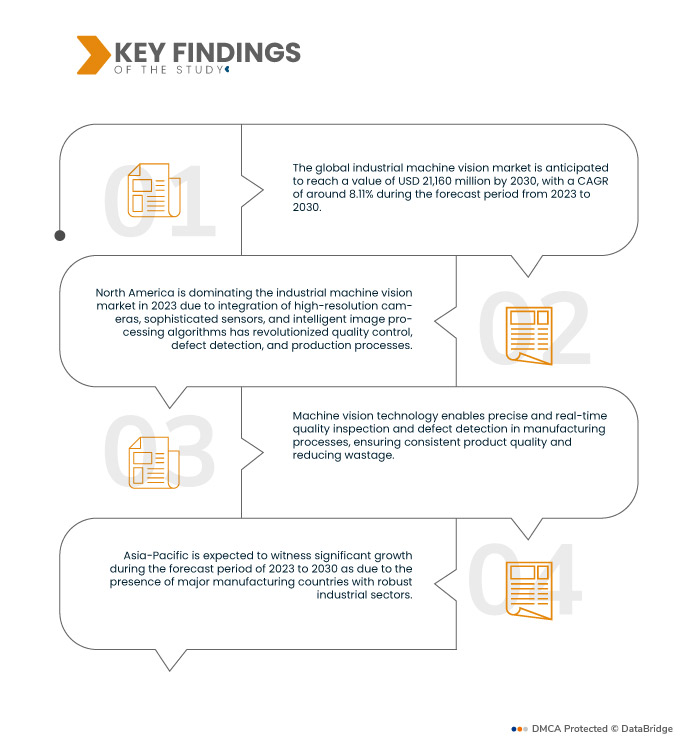Machine vision refers to the technology and methods used to provide imaging-based automatic inspection and analysis for various applications, such as automated inspection, process control, and robotic guidance. It combines hardware (cameras, sensors, and lighting) with software algorithms to capture and process images, enabling machines to "see" and make decisions based on visual data. Widely used in manufacturing, machine vision ensures quality control, improves productivity, and enhances accuracy by identifying defects, measuring dimensions, and guiding automation systems. This technology is essential in industries like automotive, electronics, food and beverage, and pharmaceuticals, driving efficiency and innovation in production processes.
Access Full Report @ https://www.databridgemarketresearch.com/es/reports/global-industrial-machine-vision-market
Data Bridge Market Research analyzes the Global Industrial Machine Vision Market is expected to reach USD 18.25 billion by 2031 from USD 10.53 billion in 2023, growing with a substantial CAGR of 7.21% in the forecast period of 2024 to 2031.
Key Findings of the Study
Increasing Adoption of Automation Across Various Industries
The increasing adoption of automation across various industries is a significant driver for the global industrial machine vision market. As companies strive to enhance operational efficiency, reduce labor costs, and improve product quality, automation technologies, including machine vision systems, are becoming essential components of modern manufacturing and production processes. Automation has revolutionized industries by streamlining operations and boosting productivity. Machine vision systems play a central role in this transformation, offering precise and reliable inspection, measurement, and control capabilities. By automating tasks such as quality inspection, sorting, and assembly, these systems enable manufacturers to operate at higher speeds and with greater accuracy. This results in faster production rates and more consistent outcomes, minimizing human error and enhancing overall operational efficiency. As industries increasingly adopt automation to maintain competitiveness, the demand for sophisticated machine vision solutions that integrate seamlessly into automated systems continues to rise.
Report Scope and Market Segmentation
|
Report Metric
|
Details
|
|
Forecast Period
|
2024 to 2031
|
|
Base Year
|
2023
|
|
Historic Years
|
2022 (Customizable to 2021-2016)
|
|
Quantitative Units
|
Revenue in USD Billion
|
|
Segments Covered
|
By Component (Hardware and Software), Product (Smart Camera/Smart Sensor Vision System, Hybrid Smart Camera Vision System, and PC based), Type (2D Vision Systems, 3D Vision Systems and 1D Vision Systems), Deployment (Robotic Cell and General), Applications (Defect Detection, Product Inspection, Surface Inspection, Packaging Inspection, Identification, OCR/OCV, Pattern Recognition, Gauging, Guidance and Part Tracking, Web Inspection, and Others), End-User (Automotive, Consumer Electronic, Food and Packaging, Pharmaceuticals, Metals, Printing, Aerospace, Glass, Rubber and Plastics, Mining, Textiles, Wood and Paper, Machinery, Solar Panel Manufacturing, and Others)
|
|
Countries Covered
|
U.S., Canada, Mexico, Germany, France, U.K., Italy, Russia, Spain, Russia, Turkey, Belgium, Netherlands, Sweden, Switzerland, Rest of Europe, China, Japan, South Korea, India, Australia, Singapore, Thailand, Malaysia, Indonesia, Philippines, Rest of Asia-Pacific, Brazil, Argentina, Rest of South America, U.A.E., Saudi Arabia, South Africa, Egypt, Israel, and Rest of Middle East and Africa
|
|
Market Players Covered
|
KEYENCE CORPORATION (Japan), OMRON Corporation (Japan), Sony Semiconductor Solutions Corporation (Japan), Cognex Corporation (U.S.), SICK AG (U.S.), Teledyne FLIR LLC (U.S.), NATIONAL INSTRUMENTS CORP. (U.S.), BASLER AG (Germany), ISRA VISION (Germany), Intel Corporation (U.S.), Texas Instruments Incorporated (U.S.), Cadence Design Systems, Inc. (U.S.), Automatic Identification Systems (UK) Limited (U.K), Kalypso: A Rockwell Automation Business (U.S.), MV Asia Infomatrix Pte Ltd (Singapore), Ceva, Inc. (U.S.), Soda Vision (Singapore), Qualitas Technologies (India), The Imaging Source, LLC (U.S.), Integro Technologies Corp. (U.S.)
|
|
Data Points Covered in the Report
|
In addition to the insights on market scenarios such as market value, growth rate, segmentation, geographical coverage, and major players, the market reports curated by the Data Bridge Market Research also include import export analysis, production capacity overview, production consumption analysis, price trend analysis, climate change scenario, supply chain analysis, value chain analysis, raw material/consumables overview, vendor selection criteria, PESTLE Analysis, Porter Analysis, and regulatory framework.
|
Segment Analysis:
The global industrial machine vision market is segmented into six notable segments based on component, product, type, deployment, application, and end-user.
- On the basis of component, the global industrial machine vision market is segmented into hardware and software
In 2024, the hardware segment is dominating the global industrial machine vision market
In 2024, the hardware segment is dominating the market with a market share of 55.42% due to the high demand for advanced imaging devices, sensors, and cameras that are essential for capturing precise visual data.
- On the basis of product, the global industrial machine vision market is segmented into smart camera/smart sensor vision system, hybrid smart camera vision system, and PC based
In 2024, the smart camera/smart sensor vision system segment will dominate the global industrial machine vision market
In 2024, the smart camera/smart sensor vision system segment will dominate the market with a market share of 55.52% due to its integration of advanced imaging, processing, and communication capabilities into a single compact unit.
- On the basis of type, the global industrial machine vision market is segmented into 2D vision systems, 3D vision systems, and 1D vision systems. In 2024, the 2D vision systems segment is expected to dominate the market with a market share of 49.67%
- On the basis of by deployment, the global industrial machine vision market is segmented into robotic cells and general. In 2024, the robotic cells segment is expected to dominate the market with a market share of 67.99%
- On the basis of by application, the global industrial machine vision market is segmented into defect detection, product inspection, surface inspection, packaging inspection, identification, OCR/OCV, pattern recognition, gauging, guidance and part tracking, web inspection, and others. In 2024, the defect detection segment is expected to dominate the market with a market share of 26.90%
- On the basis of end-user, the market is segmented into automotive, consumer electronics, food and packaging, pharmaceuticals, metals, printing, aerospace, glass, rubber and plastics, mining, textiles, wood and paper, machinery, solar panel manufacturing, and others. In 2024, the automotive segment is expected to dominate the market with a market share of 22.53%
Major Players
Data Bridge Market Research recognizes the following companies as the major players in the global industrial machine vision market that include are KEYENCE CORPORATION (Japan), OMRON Corporation (Japan), Sony Semiconductor Solutions Corporation (Japan), Cognex Corporation (U.S.), SICK AG (U.S.) among others.
Market Developments
- In March 2024, KEYENCE CORPORATION introduced its latest Vision System, the VS Series, designed to significantly enhance industrial automation. This new system features advanced image processing capabilities, high-speed inspection, and user-friendly operation, making it ideal for improving quality control and efficiency in manufacturing environments. The VS Series underscores Keyence's commitment to providing cutting-edge vision technology for diverse industrial applications
- In February 2024, OMRON Automation introduced the TM S Series Collaborative Robots in India, featuring faster joints and enhanced safety, which improved factory efficiency in shared workspaces
- In May 2024, Sony's launched IMX454 multispectral image sensor captures 41 wavelengths simultaneously, from visible to near-infrared light, using 8 filters per pixel. It enables detailed material analysis and contaminant detection in one shot, with advanced features such as defect correction and semantic segmentation, making it ideal for diverse industrial applications
- On June 2024, Basler AG acquired a 25.1% stake in Roboception GmbH, expanding their partnership. This move aimed to enhance 3D solutions for factory automation and logistics, building on their successful collaboration since 2021
- In September 2023, Cognex Corporation launched the DataMan 380, an advanced fixed-mount barcode reader, enhancing throughput in logistics and manufacturing. Its AI-driven technology and wide field of view improved code capture, outpacing conventional readers and enabling faster, more accurate operations.
Regional Analysis
On the basis of geography, the global industrial machine vision market is segmented into U.S., Canada, Mexico, Germany, France, U.K., Italy, Russia, Spain, Russia, Turkey, Belgium, Netherlands, Sweden, Switzerland, Rest of Europe, China, Japan, South Korea, India, Australia, Singapore, Thailand, Malaysia, Indonesia, Philippines, Rest of Asia-Pacific, Brazil, Argentina, Rest of South America, U.A.E., Saudi Arabia, South Africa, Egypt, Israel, and Rest of Middle East and Africa.
As per Data Bridge Market Research analysis:
North America is expected to dominate and be the fastest growing region in the global industrial machine vision market
North America will dominate the machine vision market due to its advanced industrial automation, strong presence of key market players, and high adoption of innovative technologies across industries such as automotive, electronics, and healthcare.
For more detailed information about the global industrial machine vision market report, click here – https://www.databridgemarketresearch.com/es/reports/global-industrial-machine-vision-market














